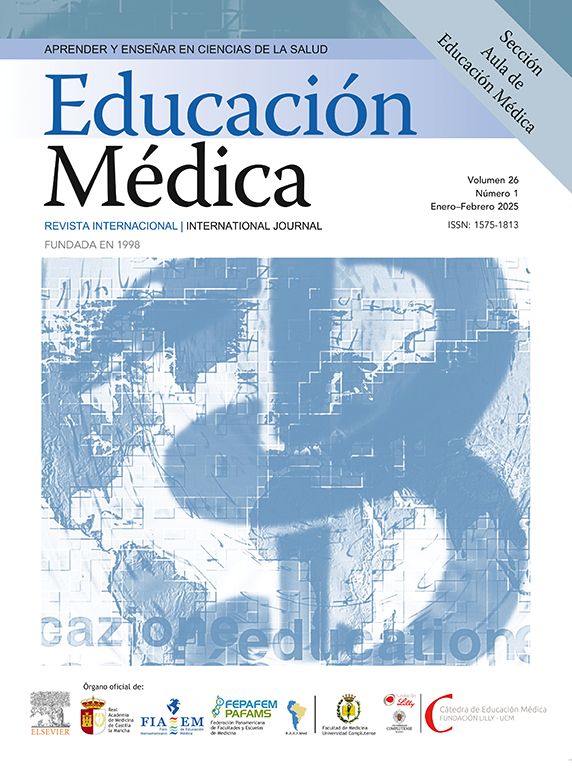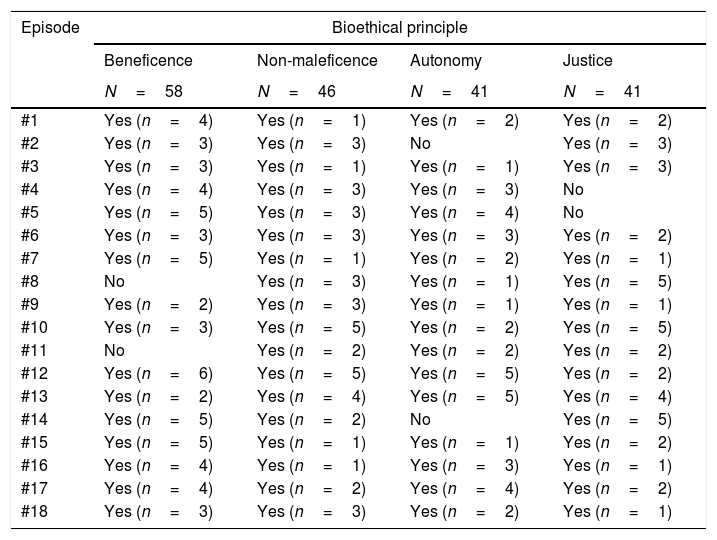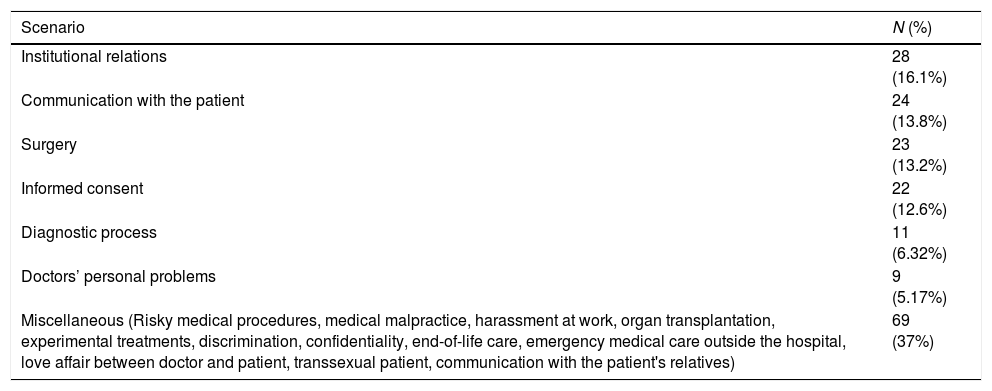Since their inception, TV medical dramas have been popular with the general public, and especially with medical students. Some educators in biomedical disciplines have used these dramas to illustrate professionalism and bioethical dilemmas. The first season of The Good Doctor, an American TV series, consisted of 18 episodes that showed the life of a young autistic physician with savant syndrome who is starting his residency in surgery. His personality gives rise to conflicts with colleagues and patients. It is hypothesised that The Good Doctor might be useful for teaching bioethics to health sciences students.
MethodsWe used content analysis for an exploratory and descriptive study of the first season to determine whether the episodes had enough scenes involving bioethical dilemmas to justify empirical studies of its teaching value. Two research questions were posed: What depictions of bioethical conflicts can be useful? And, what characteristics of the representation of the physician as an autistic with savant syndrome might be interesting for learning bioethics?
ResultsIt was found that many episodes of this TV medical drama deal with bioethical dilemmas in different scenarios. A total of 186 situations were identified in which a bioethical principle was involved. The ethical principle most often represented was charity, followed by non-maleficence (non-harming), autonomy and justice.
ConclusionThe results suggest that The Good Doctor might be useful for teaching bioethics to health sciences students.
Desde sus inicios, las series médicas han sido populares entre el público en general y especialmente entre los estudiantes de medicina. Algunos educadores en disciplinas biomédicas han usado este formato para ilustrar el profesionalismo y los dilemas bioéticos. La primera temporada de The Good Doctor, una serie de televisión estadounidense, comprende 18 episodios que muestran la vida de un joven médico autista con síndrome de Savant que está comenzando su residencia en cirugía. Su personalidad da lugar a conflictos con colegas y pacientes. Nuestra hipótesis indica que The Good Doctor podría ser útil para enseñar bioética a estudiantes de ciencias de la salud.
MétodosUtilizamos el análisis de contenido para un estudio exploratorio y descriptivo de la primera temporada para determinar si los episodios tienen suficientes escenas que involucren dilemas bioéticos para justificar los estudios empíricos de su valor docente. Se plantearon dos preguntas de investigación: ¿Qué representaciones de conflictos bioéticos pueden analizarse? Y, ¿qué características de las representaciones del médico como autista con síndrome de savant podrían ser interesantes para aprender bioética?
ResultadosDescubrimos que muchos episodios de esta serie médica tratan con dilemas bioéticos en diferentes escenarios. Identificamos 186 situaciones en las que estaba involucrado un principio bioético. El principio bioético representado con mayor frecuencia fue la beneficencia, seguida de la no maleficencia, la autonomía y la justicia.
ConclusiónLos resultados sugieren que The Good Doctor puede ser útil para enseñar bioética a estudiantes de ciencias de la salud.
TV medical dramas have been very popular since their inception.1,2 Many medical and nursing students follow these TV series,3–5 and several authors have suggested that medical dramas are interesting as a tool for teaching students in health sciences disciplines.6–9
Various factors argue in favour of using medical dramas as teaching tools. These depictions use visual language that students easily understand and trigger their emotional engagement10–16 and could increase students’ motivation and interest in understanding the scenario.13,17,18 It could also help students understand situations from the different points of view19 and develop critical thinking skills through deep analysis of the conflicts portrayed,20 especially in relation to the doctor-patient relationship.15
One of the subjects where TV medical dramas have often been used to teach is bioethics or medical ethics4,13,21–23 and many scenes depict relevant issues that might help in understanding bioethical principles.1
One of the most recent successful TV medical dramas is The Good Doctor (ABC, 2018). The main character is Shaun Murphy, a physician with autism and savant syndrome who has just started his training as a resident in surgery. He is a very special man. He is not only a young resident who learns how to be a doctor but also a person with significant limitations, in particular due to the little empathic development and the lack of communication skills with his patients and colleagues.
We hypothesised that The Good Doctor might be useful for teaching bioethics to health sciences students. We carried out a content analysis to identify plots and scenes that portray events that might be useful for teaching purposes, noting how they could be used to help students learn about topics such as doctor–patient relationship, professionalism, and ethical and bioethical dilemmas. This approach might allow us to choose the best fragments and/or episodes in terms of their pedagogical effectiveness, and to assess their usefulness for teaching bioethics.
Two research questions were posed: What depictions of bioethical conflicts can be useful? And, what characteristics of the representation of the physician as an autistic with savant syndrome might be interesting for learning bioethics?
MethodsSampleThe present study analyses the content of the 18 episodes in the first season of The Good Doctor, broadcast between September 25, 2017 and March 26, 2018.
Analytical procedure and variables of interestThe following variables were codified:
Ethical principle: We classified characters’ behaviour according to the four ethical principles delineated by Beauchamp and Childress:24 respect for autonomy, beneficence, non-maleficence, and justice.
Scenario: This variable describes the nature of the scene illustrating bioethical principles as dealing with issues in medical practice such as institutional relationships, diagnostic processes, surgery, or patient discharge.
Assigning a connection between ethical principles and scenarios enables a situational analysis of vignettes. This consists of a brief description of the relevant aspects of the scene that enable students to understand the link between the bioethical principle and the scenario. We present a brief example from episode 1×17: we analysed beneficence, non-maleficence and autonomy principles in a surgical scenario. In a meeting before surgery, where informed consent is requested, Dr. Shaun Murphy questions the risk-benefit ratio of the surgical procedure in front of the young patient to be treated, her father and the surgeons. He asks what is the need for an elective but risky surgery that only will allow the patient to smile: is the possibility to smile more important than the risks of the surgery? The importance to talk about the potential surgical risks – and not only the good outcomes of surgical procedure – is then put into question.
Coding reliabilityTwo researchers trained in bioethics independently coded the variables in the episodes under the supervision of a third researcher. Coding was done episode by episode. The third researcher sought a common delimitation for the scenarios in each situation. To harmonize the coding criteria, we conducted a pilot study on the first six episodes and three 2-h training sessions. The remaining 12 episodes were analysed one-by-one: after each analysis of an episode, the coding was checked, the coding scheme was discussed, and a consensus was reached to facilitate understanding and future work.
AnalysisWe quantitatively analysed the data to determine the frequency of appearance of the bioethical principles and the different scenarios considered in the episodes. This will allow measuring and quantifying the value of The Good Doctor for teaching bioethics to health sciences students. We were also interested in knowing the variety of bioethical principles and scenarios, and understanding that, in a greater variety, a more complex and rich look on bioethical situations occurs.
To answer the question of what characteristics of the representation of the physician, as an autistic with savant syndrome, might be interesting for learning bioethics, we used interpretive description25–27 to analyse the depiction of situations that involve Dr. Murphy beyond the analysis of the frequency of appearance of these vignettes.
ResultsIn the first season of the medical drama, 186 situations were identified where a bioethical principle was involved. Table 1 shows the distribution of the appearance of each bioethical principle through the 18 episodes. The principle of beneficence is the most frequent (31.2%), followed by non-maleficence (24.7%), autonomy (22%), and justice (22%).
Frequency of situations involving bioethical principles in episodes of the first season of The Good Doctor and the mean number of these situations per episode.
| Bioethical principle | Number of situations involving bioethical principles | Mean |
|---|---|---|
| Beneficence | 58 | 3.22 |
| Non-maleficence | 46 | 2.55 |
| Autonomy | 41 | 2.27 |
| Justice | 41 | 2.27 |
Table 2 summarises the distribution of situations involving bioethical principles in each episode. All four bioethical principles were dealt with in two-thirds of the episodes, often in more than one situation; three bioethical principles were dealt with in the remaining third of the episodes.
Distribution of situations dealing with bioethical principles in the episodes of the first season of The Good Doctor.
| Episode | Bioethical principle | |||
|---|---|---|---|---|
| Beneficence | Non-maleficence | Autonomy | Justice | |
| N=58 | N=46 | N=41 | N=41 | |
| #1 | Yes (n=4) | Yes (n=1) | Yes (n=2) | Yes (n=2) |
| #2 | Yes (n=3) | Yes (n=3) | No | Yes (n=3) |
| #3 | Yes (n=3) | Yes (n=1) | Yes (n=1) | Yes (n=3) |
| #4 | Yes (n=4) | Yes (n=3) | Yes (n=3) | No |
| #5 | Yes (n=5) | Yes (n=3) | Yes (n=4) | No |
| #6 | Yes (n=3) | Yes (n=3) | Yes (n=3) | Yes (n=2) |
| #7 | Yes (n=5) | Yes (n=1) | Yes (n=2) | Yes (n=1) |
| #8 | No | Yes (n=3) | Yes (n=1) | Yes (n=5) |
| #9 | Yes (n=2) | Yes (n=3) | Yes (n=1) | Yes (n=1) |
| #10 | Yes (n=3) | Yes (n=5) | Yes (n=2) | Yes (n=5) |
| #11 | No | Yes (n=2) | Yes (n=2) | Yes (n=2) |
| #12 | Yes (n=6) | Yes (n=5) | Yes (n=5) | Yes (n=2) |
| #13 | Yes (n=2) | Yes (n=4) | Yes (n=5) | Yes (n=4) |
| #14 | Yes (n=5) | Yes (n=2) | No | Yes (n=5) |
| #15 | Yes (n=5) | Yes (n=1) | Yes (n=1) | Yes (n=2) |
| #16 | Yes (n=4) | Yes (n=1) | Yes (n=3) | Yes (n=1) |
| #17 | Yes (n=4) | Yes (n=2) | Yes (n=4) | Yes (n=2) |
| #18 | Yes (n=3) | Yes (n=3) | Yes (n=2) | Yes (n=1) |
We identified 18 scenarios dealing with issues in medical practice that illustrate biomedical ethics (Table 3). Scenarios that were present in less than 5% of situations are grouped in the Miscellaneous category.
Scenarios and frequency of appearance.
| Scenario | N (%) |
|---|---|
| Institutional relations | 28 (16.1%) |
| Communication with the patient | 24 (13.8%) |
| Surgery | 23 (13.2%) |
| Informed consent | 22 (12.6%) |
| Diagnostic process | 11 (6.32%) |
| Doctors’ personal problems | 9 (5.17%) |
| Miscellaneous (Risky medical procedures, medical malpractice, harassment at work, organ transplantation, experimental treatments, discrimination, confidentiality, end-of-life care, emergency medical care outside the hospital, love affair between doctor and patient, transsexual patient, communication with the patient's relatives) | 69 (37%) |
The most frequent intersections between the bioethical principles and the scenarios are: Autonomy and Informed consent (n=22; 12.6%), Justice and Institutional relations (n=20; 11.5%), Beneficence and Surgery (n=15; 8.6%), and Non-maleficence and Surgery (n=10; 5.7%).
The premise of The Good Doctor centres on the main character's difficulties in interpersonal relationships and communication, so it is interesting to analyse qualitatively how these difficulties intersect with bioethical principles and the doctor-patient relationship in the series. An example: in episode #17 (entitled Smile), the patient is a young woman in her twenties who has Moebius syndrome, in which paralysis of the sixth and seventh cranial nerves makes it impossible to smile and express emotions facially. The similarities with Dr. Murphy's expressionless face are obvious, but the patient does have a sense of humour and makes jokes about her condition. When Dr. Murphy evaluates the patient in the preoperative appointment, he questions the usefulness of the operation by asking “Do you want to be a comedian?” This question is shocking in that it implies that Dr. Murphy can only imagine the need to smile professionally, so he thinks that the risks of this elective surgery might outweigh the benefits. When the patient changes her mind about having surgery, the head of the department reproaches Dr. Murphy for saying what he did. Dr. Murphy reminds his chief that it is important to talk about the risks of a procedure—not only the benefits. In this discussion of beneficence and non-maleficence, Dr. Murphy's inability to empathize with his patient becomes a way to protect her, because it restores the young woman's autonomy.
DiscussionThe present study found that The Good Doctor medical drama is rich in bioethical conflicts. This series covers a wide variety of situations in which bioethical themes can arise. Our results confirm the potential interest of this medical drama for teaching bioethics in health sciences.4,7,9
This study aimed to answer two research questions in reference to the series. The first asked what depictions of bioethical conflicts could be useful for teaching purposes. The principles of beneficence and non-maleficence continue to be the guiding principles of medical practice, and they are represented in most of the vignettes. On the other hand, all four principles are frequently depicted and none of them is neglected; thus, the series provides a comprehensive view of issues that arise in medical practice.
In addition to bioethical principles, we included the scenario as a variable of analysis. Including this variable enabled us to explore the resources from the series that might be useful for teaching in various specific concrete situations, and allowed us to expand the state of the art on bioethics and TV series, since there are no bibliographical references on this subject. In fact, the use of TV medical series for teaching purposes is quite unusual.1,2,9,14,15,17,18,22
Our second research question asked what characteristics of the physician as an autistic person with savant syndrome might be interesting for learning bioethics followed Ye and Ward27 indispensable contributions to the content analysis of medical dramas, although focused on the analysis of the types of diseases portrayed and their treatments, rather than on bioethical dilemmas as in our study. In analysing the second research question, we placed special emphasis on the effects of Dr. Murphy's difficulties in communicating with his patients and colleagues. His autism makes it difficult for him to relate others, which can obviously cause problems in the doctor–patient relationship. However, his autism also conditions him to have an enormous respect for the rules and to do his job as best he can. His main problem is in a lack of tact, coming off as brusque with the patients and suggesting a lack of empathy. However, this representation could help students identify the ethical conflicts that result from this behaviour and its effects on patients and medical colleagues. Thus, we consider that this character is especially relevant in showing the importance of empathising with patients and colleagues.
This study has some limitations. Although measures were taken to ensure a thorough evaluation of the content, only three researchers took part in this task. Repeating this study on a larger scale would increase its validity and reliability. A final limitation comes from the production characteristics of the series. Like most medical dramas, The Good Doctor comes from the United States, so it is culture-bound to that country and the structure of its health system, among other features.
In conclusion, our results show that The Good Doctor contains much material related to bioethical issues in a wide variety of scenarios. These findings suggest that this series could be used to teach bioethics to students of health sciences. Empirical studies are necessary to determine the theoretical and practical implications of using The Good Doctor to analyse bioethical issues in specific scenarios of practice and the pedagogical effectiveness of this approach.
Conflict of interestNo potential conflict of interest was reported by the authors.











